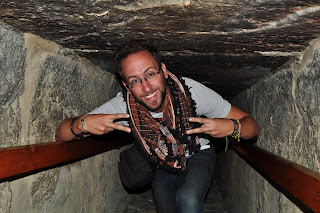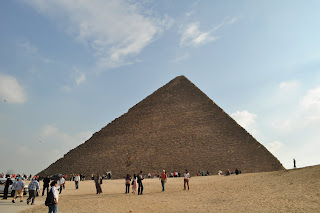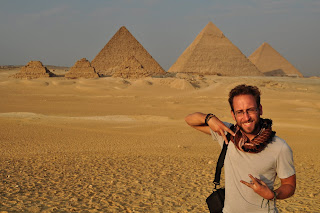Dec 7th - 10th
Our overnight bus-ride from Siwa to Cairo was more efficient than expected. We stepped off the bus and were standing at the side of an overpass at barely five in the morning. We hailed a cab and were quickly on our way towards Nasr City, the district where we were scheduled to meet our friend Magdi.
As we drove through the darkness, any repose we wished to enjoy was dashed by the unabating honking of our cab driver. Despite the relative lack of other drivers on the road, he still honked at a frequency of at least 10 honks per minute. When asked why he was honking so much, he merely stated that he was just 'practicing'. What we were not aware of at that time, but that soon became quite apparent, was how this cab-ride would serve as our acclimatization to the chaotic energy (and constant noise) that Egypt's capital city, Cairo, is renowned for.
Chris had called Magdi while we were still in the cab, and our groggy host gave the driver directions to his flat. We arrived shortly after and were welcomed by our friend who we had last seen in Uganda's capital city, Kampala, an astonishing 3317 km away.
Magdi was in the process of trying to sell his flat/office, and the sleeping arrangements reflected the sparsity of the remaining furniture. Chris and I grabbed some sofa cushions, set them up in a neat row, and lay down to try to get some sleep. However, Cairo had other ideas, and although it was only 6 am by this point, the traffic already extended as far as the eye could see, and the honking poured in through the open window like a siren blaring, warning of impending doom.
Since the prospect of sleep seemed to be beyond our grasp, we sat and talked to Magdi over some delicious Egyptian tea; and discussed what Chris and I would like to do during our stay in Cairo. Our first order of business was to visit the Museum of Egyptian Antiquities, or the Egyptian Museum as it is commonly known. After grabbing a quick bite to eat, we were soon on our way.
Our microbus dropped us off in Tahrir Square, the now infamous square where the world watched as the 2011 Egyptian Revolution unfolded. At this time, the square represented nothing more to us than a large, open area surrounded by office buildings and chaotic traffic, right in the city center.
We walked towards the reddish-pink building and found the entrance of the museum to be swarming with tourists. To my dismay, I had to check-in my camera because no photography is allowed within the building. I just prayed that it would still be there upon my return.
We spent several hours wandering through the expansive rooms and vast corridors. The sheer amount of relics, statues, and ancient artifacts was overwhelming. I tried to read as many of their descriptions as possible, but I soon gave up. There was far too much to read.
Out of the all the exhibits from all the pharaonic dynasties, I found the most impressive to be that of King Tutankhamun's, or King Tut's tomb. They practically devoted an entire wing to the contents found within his burial chamber. King Tut's tomb had been discovered accidentally in 1922 by Howard Carter and was one of, if not the most intact tombs ever discovered. This meant that nearly all of the treasures and riches that he was buried with were still present upon its discovery. The most impressive and iconic item was the young King's solid-gold burial mask. To see it in person, gave one a sense of how opulent the Pharaohs were and how divine they were considered.
After our day at the museum, we wandered around the streets of central Cairo, enjoying tea, shisha and some well-deserved kushari: an Egyptian pasta-like dish made with macaroni, lentils and tomato sauce. Aside from the frequent traditional Egyptian breakfast of ful: cooked and mashed fava beans served with olive oil, chopped parsley, onion, garlic and lemon juice; we ate very little Egyptian fare in Cairo. Magdi lived near a cheap and quite delicious Thai restaurant and we pretty much ate dinner there for a majority of the nights we were in Cairo.
Some of the other activities we did while there were wander around Old Cairo and Islamic Cairo at night. Aside from the ancient buildings and numerous mosques, it reminded me of Montreal due to pretty much everything being under construction and the scaffolding lining the streets. In Islamic Cairo, we also visited Khan el-Khalili, a major souq, or market, and got lost in the many winding streets and attractive shops.
We were nearing the end of our stay in Cairo and we still hadn't visited what most tourists come to the country in order to see: the mighty Pyramids. Magdi had managed to borrow his nephew's car and we set off to see these iconic structures. Rather than starting off with the Great Pyramids of Giza, we had decided to first visit two other sites on the recommendation of our Czech friend, and amateur Egyptologist, Robert.
As we drove along the Nile to our first destination, we saw landscapes of palm trees and sand dunes to the west, which were flanked by numerous pyramids, jutting out towards the heavens as they have for millennia. Simply stunning. And ridiculously distracting. I'm glad I wasn't driving!
Our first stop was Dashur, located only 40-kilometers south of Cairo. Dashur is the site of two of the oldest, largest and best-preserved pyramids in all of Egypt. They were constructed by the Pharaoh Sneferu and are known today as the 'Bent Pyramid' and the 'Red Pyramid' respectively.
We first made our way to the Red Pyramid. Much like the Great Pyramids in Giza, you can enter into its deep inner chambers, descending nearly 200 feet. But unlike the Great Pyramids, the lack of thousands of tourists with the same idea, made this experience that much more novel, and peaceful. We spent several minutes in the inner chambers before we succumbed to the humidity, and climbed our way back to the entrance. We then proceeded to walk around its perimeter before making our way to the 'Bent Pyramid'.



What is rather interesting about the Bent Pyramid, is that it clearly demonstrates the transition of pyramid architecture: showing the progress from the early step-pyramid design to the smooth-sided design used in the Red Pyramid.

The "bend" results from the change in angle from 55 degrees in the lower portion of the pyramid to the shallower 43 degrees in the upper portion. The newer Red Pyramid was then constructed using only the upper 43-degree inclination, from base to apex, resulting in the smooth-sided pyramid we all know and love.

From there we drove north along the Nile to the Saqarra Necropolis, home to the Pyramid of Djoser. This was ancient Egypt's first pyramid and is believed to be the world's oldest large-scale, cut-stone construction. Built for the Pharaoh Djoser in the 27th century BC, this pyramid marks the beginning of Egypt's pyramidal dynasty. Having no architectural predecessor to base this initial model on, it was constructed completely in a step-pyramid design.


Now that we had visited Egypt's oldest pyramid, and also witnessed the transition from step-pyramid to the smooth-sided pyramid at Dashur, we were now ready to behold the pinnacle of Egypt's pyramidal legacy: the Great Pyramids of Giza.
Magdi didn't want the guards at the entrance asking him too many questions regarding how he knew us and such, so he told me to get into the driver's seat. Then he and Chris went to buy tickets at the ticket-office and the guard just waved me through and motioned where I should park. Being a white tourist in Egypt, you rarely get questioned. So I just drove some random person's car, with no driver's license may I add, into the parking lot of the world's most famous ancient monument, and because I didn't pass through the ticket office, I didn't even have to pay for a ticket!
No matter how many times you see the Great Pyramids on tv, in magazines, or in just about any other form of media, you can still never fathom how impressive and humbling these immense structures truly are in person. Built around 2550 BC to 2490 BC, these prodigious tombs are by far the oldest and only remaining wonder of the ancient world.

I met Magdi and Chris near the ticket office and we walked towards the oldest and largest of the Great Pyramids, that of Khufu (also known as Cheops). Built by the pyramid's namesake, consisting of 2.3 million stone blocks, each weighing between 2.5 and 15 tons, bringing this colossal structure's height to a staggering 481 feet (147 meters).


Chris and I took some time to climb up the side of this herculean tomb, and gain perspective on just how impressive the structure and its construction really were.
Chris and I continued along the man-made road, dodging touters trying to get us to buy camel rides or various other services, until we were now standing next to the Great Pyramid of Khafre. Although Khafre's father, Khufu, had constructed a larger pyramid than his son, 481 ft (147m) versus 471 ft (144m), Khafre compensated like only an Egyptian Pharaoh could: by building his pyramid on a higher elevation and by erecting a giant, man-faced lion (The Sphinx) guarding his tomb!

We continued until we reached the third of the Great Pyramids, the pyramid of Menkaure. After seeing all the other astounding pyramids we had seen that day, Menkaure's puny 213 ft (65 meter) pyramid, didn't seem so impressive anymore. So rather than walking around it, Chris wanted a touristy, yet-still-incredibly-alluring, camel-ride near the pyramids, and I asked his owner for the best place to take a picture of all the Great Pyramids together. I made my way there on foot and Chris got a leisurely camel ride.

Once there, we took a few moments to admire the ancient wonder that stood before us and had humbled countless foreigners over the millennia. This vantage point was utterly fantastic and because it was nearing sundown, most of the tourist groups had already left, leaving us with an unadulterated perspective on these immense structures that nearly brought tears to my eyes. We took some pictures together, individually and Chris got a picture with his camel and the touter told us we needed to make our way to the exit before the site closes. Once again he offered to let me share Chris' camel, but I told him I would rather walk. He then challenged me to a race to the Sphinx, which I eagerly accepted, yet ultimately lost.
Once at the Sphinx, the gigantic lion with Pharaoh Khafre's (or so they speculate) face, I waited in an immense line of people trying to get a glance of the iconic statue as the sun descended in the sky behind the Great Pyramids. The wait was more than worth it and despite the thousands of people shouting and taking awkward pictures around me, everything went silent. I felt as if I was alone.


As I made my way back to join my friends, I looked back and saw the Sphinx staring towards the city of Giza, guarding the Great Pyramids as he has been for over 4500 years. With all of the turmoil throughout the Middle-East and the rest of the world, I wondered how long this once inevitable truth would stand. God willing my question will never be answered. At least with any other response than for the rest of time.
One can only hope.












No comments:
Post a Comment